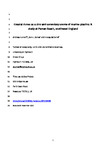Coastal dunes as a sink and secondary source of marine plastics: A study at Perran Beach, southwest England
| dc.contributor.author | Turner, Andrew | |
| dc.contributor.author | Amos, SL | |
| dc.contributor.author | Williams, T | |
| dc.date.accessioned | 2022-02-08T12:58:49Z | |
| dc.date.issued | 2021-12 | |
| dc.identifier.issn | 0025-326X | |
| dc.identifier.issn | 1879-3363 | |
| dc.identifier.other | 113133 | |
| dc.identifier.uri | http://hdl.handle.net/10026.1/18690 | |
| dc.description.abstract |
Plastic food packaging and containers (n = 263) have been retrieved from the scarped foredunes at Perran Beach, SW England, following a storm surge. Samples displayed evidence of cracking, scratching, discolouration, staining and hydroxyl and carbonyl stretching, but legible text indicating their origin, dates of manufacture/expiration, packaging codes and logos, coupled with online product searches, allowed 25 food packets and 87 containers to be aged. Estimates of food packaging age spanned a 43-year period (1975-2018), with a median age of 25 years, while estimates for containers spanned 57 years (1962-2019), with a median age of 19 years. Plastic derived from local littering and offshore sources appears to be trapped within the foredunes for years to decades and subsequently released as "fresh" beach litter following surges sufficient to effect scarping. Dunal systems may act as significant reservoirs of historical plastics and play a critical role in their recycling and retention in the coastal zone. | |
| dc.format.extent | 113133-113133 | |
| dc.format.medium | Print-Electronic | |
| dc.language | en | |
| dc.language.iso | en | |
| dc.publisher | Elsevier BV | |
| dc.subject | Coastal dunes | |
| dc.subject | Historical plastic litter | |
| dc.subject | Food packaging | |
| dc.subject | Bottles | |
| dc.subject | Storm surge | |
| dc.title | Coastal dunes as a sink and secondary source of marine plastics: A study at Perran Beach, southwest England | |
| dc.type | journal-article | |
| dc.type | Journal Article | |
| plymouth.author-url | https://www.webofscience.com/api/gateway?GWVersion=2&SrcApp=PARTNER_APP&SrcAuth=LinksAMR&KeyUT=WOS:000744261600001&DestLinkType=FullRecord&DestApp=ALL_WOS&UsrCustomerID=11bb513d99f797142bcfeffcc58ea008 | |
| plymouth.issue | Pt B | |
| plymouth.volume | 173 | |
| plymouth.publication-status | Published | |
| plymouth.journal | Marine Pollution Bulletin | |
| dc.identifier.doi | 10.1016/j.marpolbul.2021.113133 | |
| plymouth.organisational-group | /Plymouth | |
| plymouth.organisational-group | /Plymouth/Faculty of Science and Engineering | |
| plymouth.organisational-group | /Plymouth/Faculty of Science and Engineering/School of Geography, Earth and Environmental Sciences | |
| plymouth.organisational-group | /Plymouth/REF 2021 Researchers by UoA | |
| plymouth.organisational-group | /Plymouth/REF 2021 Researchers by UoA/UoA07 Earth Systems and Environmental Sciences | |
| plymouth.organisational-group | /Plymouth/Research Groups | |
| plymouth.organisational-group | /Plymouth/Research Groups/BEACh | |
| plymouth.organisational-group | /Plymouth/Research Groups/Marine Institute | |
| plymouth.organisational-group | /Plymouth/Users by role | |
| plymouth.organisational-group | /Plymouth/Users by role/Academics | |
| dc.publisher.place | England | |
| dcterms.dateAccepted | 2021-11-08 | |
| dc.rights.embargodate | 2022-11-19 | |
| dc.identifier.eissn | 1879-3363 | |
| dc.rights.embargoperiod | Not known | |
| rioxxterms.versionofrecord | 10.1016/j.marpolbul.2021.113133 | |
| rioxxterms.licenseref.uri | http://www.rioxx.net/licenses/all-rights-reserved | |
| rioxxterms.licenseref.startdate | 2021-12 | |
| rioxxterms.type | Journal Article/Review |


